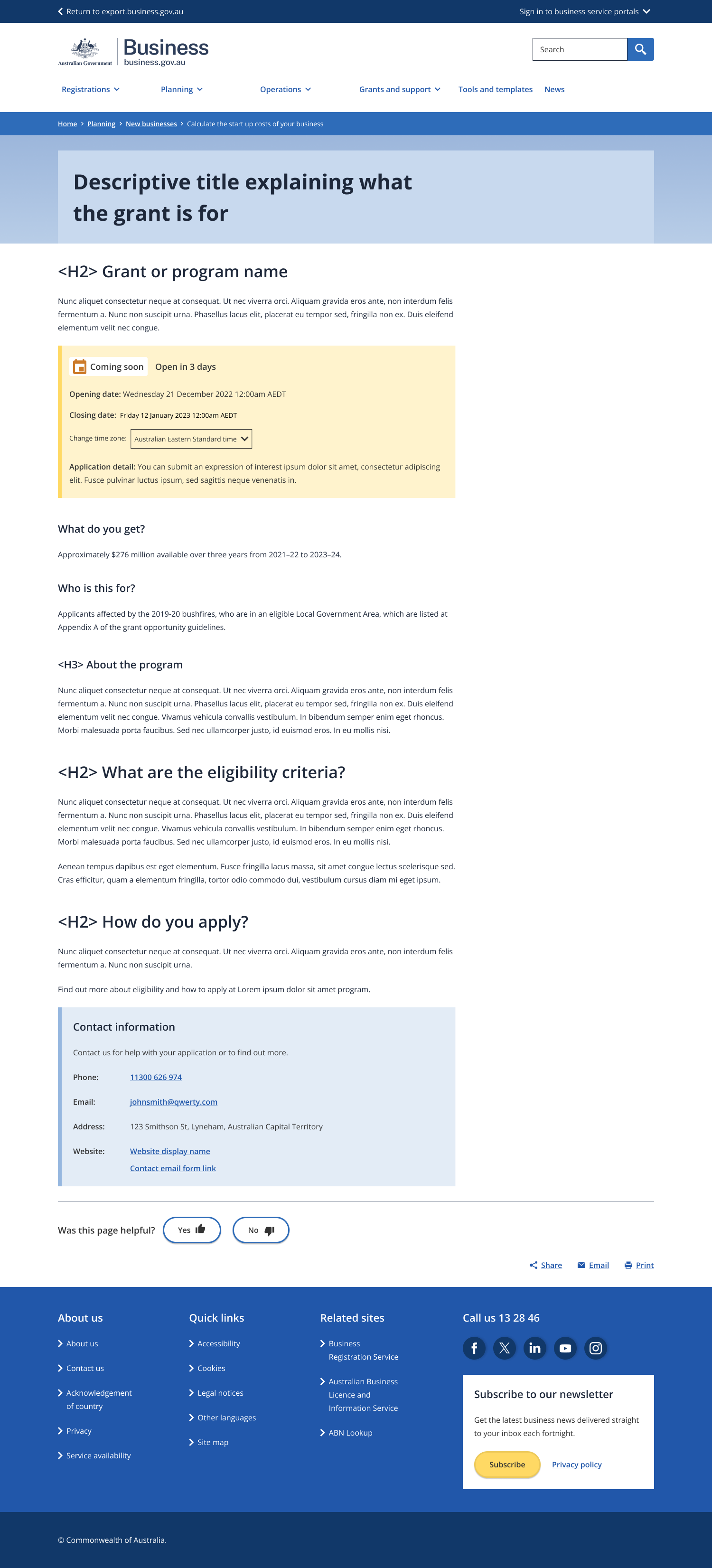Page anatomy
Page layout
The external grant page uses the single column - information page layout.
A plain language description of the program.
- Use plain language to describe the program’s purpose
- Must describe the grant and its benefits for business. Use a similar format to: [Offering] for [customer] to [outcome].
- Maximum character limit of 90.
H2 name of program, duplicate information of label program name (SEO benefits)
- Must be the proper title of grant or assistance name.
- May use acronyms in brackets after full name.
- May include round details if required e.g. Round 5.
- If it is a state specific grant/program, add the acronym of the state to the end of the grant name (unless it is part of the grant name).
A short plain language paragraph that explains in more detail what the program is about. This is the text that will appear in Search.
- Include the top three keywords for the page.
Status to describe whether you can apply for the program.
- Coming soon = Program is not yet open to applications but will be soon.
- Open = Currently open to applications
- Closed = Closed program, not currently accepting applications, but another round is expected
The date and time that the grant opens.
- Optional.
- Do not include past dates (e.g. if the grant/program is already open).
The date and time that the grant closes.
- Optional
- Do not include past dates (e.g. if the grant/program is already closed).
Used to provide more complex information on program timelines. This will appear on the content page and in the search results (if required).
- Optional – only use if required.
- Don’t repeat information from status field.
Examples:
- Apply at any time.
- Applications will close when funding is exhausted.
Briefly state the amount or offering only.
- No lead in sentence.
- Avoid bullet points.
- Must state type of assistance (e.g. grant, loan).
- Must include specific amounts (e.g. $20,000).
- Must include any contribution amounts required by the business (e.g. 50% of your expenditure).
- Recommended maximum 200 characters.
Describes who the assistance is for. This will appear on the content page and in the search results.
- No lead in sentence.
- Avoid bullet points.
- Must state the type of business that can apply (e.g. small business, company, research organisation, farmer).
- We provide eligibility details in the eligibility criteria section within the content. Don’t repeat these details here.
- Recommended maximum 200 characters.
The aim for this section is to provide enough information for the reader to determine if the program will suit their business need.
- Write in plain English.
- Start with the full name of the grant/program.
- Describe what the grant/program is and how it can help business in practical terms.
- May include specific information about support including amounts, percentages the funding covers, and other services. This is not needed if it replicates information already provided in What do you get? and Who is this for? fields.
This section should help the reader decide if they will generally be eligible for the grant/program and if it’s worth their time applying.
- Include the basic requirements to qualify for the grant or assistance.
- If the criteria are complex, put in the general ones and then refer customers to the source website for the full set of criteria.
- When linking, use the sentence “Find out more about the eligibility criteria at [page title and link]”.
This section provides information to readers on how they can apply for the grant/program.
- It will usually be a standard sentence to refer customers to the source website e.g. “Find out more about how to apply at [page title and link].”
- May include any relevant information for applying e.g. “Before you apply you need to first contact a program manager”.
Provide contact details (phone, email, contact web page) for customers to find out more about the grant/program.
Include:
- a main office or switch phone number (no brackets)
- a generic email address (not personal), or
- a link to a ‘Contact us’ form (note that links display as full URL).
Guidelines for use
Purpose
An external grant landing page is a single page containing information about an external grant (non-AusIndustry). The page provides information about funding amounts, eligibility, application process, and contact details for the external department responsible for the grant.
It should always include:
- An explanation of what the grant is, who it is for and the grant value
- The following headings:
- What are the eligibility criteria?
- How do I apply?
- A plain language explanation of the eligibility criteria and link to external website for more information
- H2s are used to determine left-hand-navigation
- An link to the grant information on the external website
- A maximum 90 character metadata description for search (this does not appear on the page).
